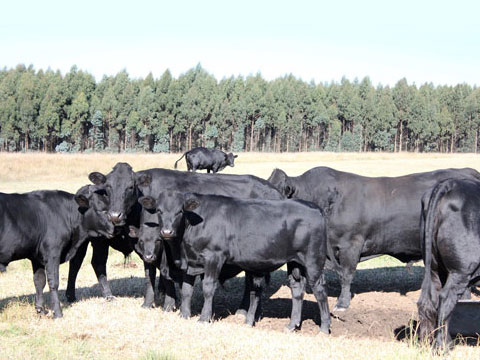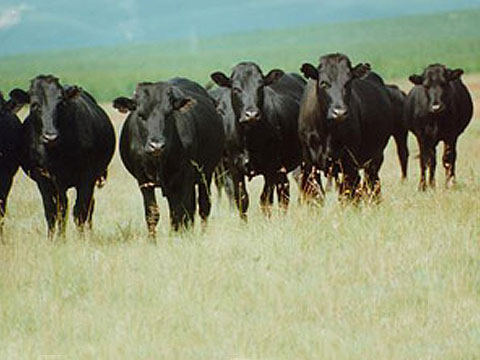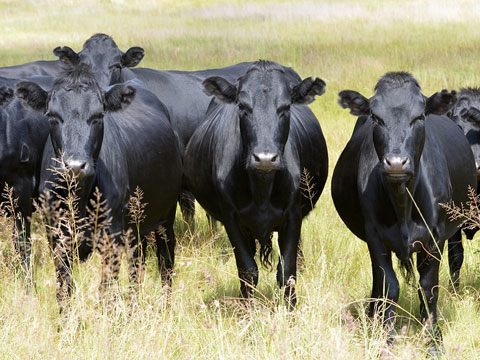Buffalo valley cows, aged between 5 and 8 years, with calves of about 5 to 6 months. The cows are a typical example of the medium-frame animal that can be farmed cost-effectively on natural veld grazing.
Buffalo Valley het ’n lang en kleurvolle geskiedenis. Dit is beslis nie ’n oordrywing as ons die stelling maak dat daar baie mense betrokke was met die skryf van die BV verhaal. Daar was opdraandes en afdraandes. Ons het saam gelag en saam gehuil. Die resultaat soos dit vandag daar staan, is pragtig, met ’n lang en blink toekoms wat wink. Soos met enige storie, het dit ’n begin en dit is waar ons gaan begin.
Buffalo Valley came into being when John and a partner, both born and bred townsmen, entered farming with the purchase of a Highveld farm, with the aim of producing milk from the veld. (A decade or two, three, ago this was common practice throughout the country). Dairy breeds were used, but it was found that the cows yielding the greatest volume of milk under Highveld conditions were black cows, or so-called Veld Friesians, later identified by the pundits as Drakensbergers. These black cows formed the nucleus of the Buffalo Valley’s Drakensberger stud of today.
Na aanleiding van die hoë melkproduksie van die sogenaamde Veld Friese betree Buffalo Valley in 1968 tot die stoetbedryf. Die eerste 80 verse word vanaf Hofni Schoeman aangekoop en die Veld Friese word as F1 Drakensbergers gebrand. Verdere aankope geskied hierna, tw. ou Drakensberger Stoetkoeie vanaf Mnre. John de Jager (Kranspoort), Koos Botha (Mambane), Beukes Willemse (Meulstroom), Neil Reinecke (Toronto) en Willem Pieters. Een spesifieke koei verdien spesiale vermelding, Kranspoort 188. Sy is aangekoop met ’n top bulkalf aan sy, Kranspoort 117. Kranspoort 117 staan later vry algemeen bekend as K 117. Hy kan as die vader van die BV bloedlyn omskryf word en lewer ook ’n wesenlike bydrae tot die Drakensberger ras in die algemeen.
From the outset, all animals were tested through the National Performance Testing Scheme. These scientific norms formed, and still do, an integral part in the selection and development of the BV stud. Right from the beginning every young bull in the stud was subjected to Phase C growth tests in order to monitor the standing of the stud in respect to the breed. At the same time participation in shows was undertaken to phenotypically evaluate the breed purity of the animals. The Phase C test was later altered to an extensive, on the veld farm Phase D test after weaning.
Na afloop van die Fase D toets, word alle bulle wat geslaag het, aan ’n veldtoets met slegs ’n sout/fosfaat lek onderwerp. Hierdie toets duur tot en met die begin van die finale voorbereidings fase vir die jaarlikse produksieveiling. Daar mag dan ook van aangeplante weidings gebruik gemaak word in die nasomer. Die doel van die veldtoetse is om die aanpasbaarheid en groeivermoë van die bul op die veld te toets. Alle resultate word dan ge-indekseer en gemelde inligting aan die voornemende kopers beskikbaar gestel. Hierdie stelsel is reeds so vêr terug as 1985 begin, en staan vandag bekend as die BV Suurveld Bul Projek. (Verwys: ”Buffalo Valley - Back to Basics, The Veld”)



Buffalo Valley is situated 15 km East of Carolina, 6 000 ft (1 835 m) above sea-level, with an average rainfall of ± 900 to 1 000 mm. The topography is rolling hills with deep valleys. The farm is located in the mist-belt of the eastern Highveld. The summers are short, wet and cool, the winter’s dry and icy cold with frost from April to September. Snowfalls occur most years.
In consequence the natural grazing is sourveld with tulip infestation in the valleys. They are also subject to severe Redwater and Gallsickness infestation. The sourveld has an exceptionally high nutritional value from November to February when the protein component of the veld grass can be as high as 12%. After February, however, the nutritional value declines rapidly to a mere 2% protein content in the winter.
Neither the topography nor the climate is suitable for crop production. Established pastures, however, flourish remarkably well in this environment and are planted for the production of hay, which serves as a most important feed source during the cold winters.